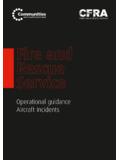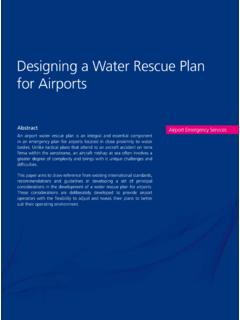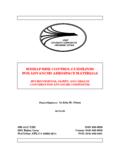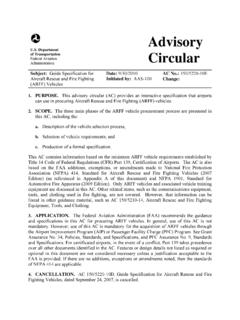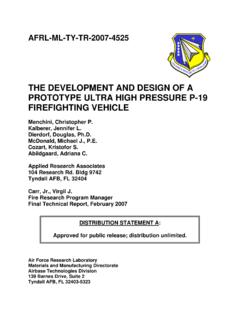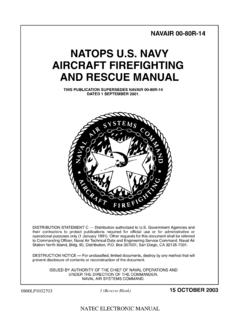Transcription of Aircraft Accidents that Caused Major Changes to …
1 Aircraft Accidents that Caused Major Changes to Emergency Response Equipment and procedures Presented by: Mark T. Conroy Senior Fire Protection Engineer National Fire Protection Association, USA Presented at: The International Forum on Emergency and Risk Management Singapore Aviation Academy 10-12 January, 2005 Crash of United Airlines Flight 232, Sioux Gateway Airport, 19 July, 1989 The Flight A DC-10 was en-route from Denver to Chicago on July 19, 1989 when a loud noise was heard in the Aircraft s tail mounted engine. Unknown to the cockpit crew at the time, the engine fan assembly had failed, sending engine parts through the right horizontal stabilizer. The flight crew quickly realized that they had lost all three hydraulic systems that powered the Aircraft s flight controls. The Aircraft could now only be controlled using the throttles. The captain began emergency landing procedures and discovered that the nearest airport was the Sioux City Gateway Airport.
2 The Airport The Sioux City Gateway Airport is a Category 6 airport. Aircraft rescue and fire fighting (ARFF) services for a DC-10 would match that required for a Category 8 airport (see NFPA 403, Standard for Aircraft Rescue and Fire Fighting Services at Airports for information on airport categories). The extinguishing agent required for a Category 8 is more than double that required for a Category 6. Three ARFF vehicles would be needed for a Category 8, versus 2 for a Category 6. ARFF Services The airport is a joint use airport which means that it is used for both civilian and the Air National Guard (military). The ARFF services for the airport are provided by the Air National Guard. The airport fire department had available, the following vehicles: P-19 ARFF vehicle with 1000 gallons of water and aqueous film forming foam (AFFF) Aircraft Accidents that Caused Major Changes To Emergency Response Equipment and procedures Page 2 P-4 ARFF vehicle with 1500 gallons of water and AFFF P-13 ARFF vehicle with 350 pounds of dry chemical and 500 pounds of Halon 1211 P-18 Tanker truck with 2000 gallons of water for replenishment of the ARFF vehicles P-10 Rescue Vehicle Pre- accident Positioning of Vehicles Upon receiving information on the in-flight emergency, the 5 ARFF vehicles were dispatched.
3 Additionally, 4 city fire department vehicles were dispatched. The responding vehicles received information that the Aircraft might not reach the airport and that it could crash approximately 5 miles south of the airport. Therefore, some of the city vehicles were traveling on the interstate highway in anticipation of the Aircraft crashing off-airport. They were later updated that the Aircraft would make it to the airport and would land on runway 31. The ARFF vehicles took positions along that runway. The city vehicles including two engine companies, a command vehicle and an ambulance responded to their pre-assigned standby positions on the airport property prior to the crash. Adding to the safety concerns was the location of two A-10 fighter Aircraft that had just landed and were at the end of runway 31 in the direct path of the DC-10 if it were to either need the full length or overshoot the runway.
4 Impact and Wreckage At the last minute, the fire department was informed that the Aircraft would not make it to runway 31 and it was coming in on runway 22 which had been closed for some time and was no longer used for take-off and landing. Some of the ARFF vehicles were actually on runway 22 and had to move quickly to get off. Before all units had a chance to reposition, the Aircraft touched down and began to break-up in a massive fireball rolling down the runway. The center section of the Aircraft , which contained most of passengers, became inverted and ended up in a corn field, more than 3700 feet from the point the Aircraft initially touched the runway. The Response The firefighters proceeded cautiously in the ARFF vehicles through the trail of wreckage in order to avoid injuring or killing survivors. After briefly inspecting the large tail section, they proceeded to the center section.
5 On the way to the center section, firefighters noticed passengers still strapped in their seats and many walking along the runway. Firefighting Upon arrival at the center section, a large fire was encountered, which was mostly on the exterior of the wreckage. The fire was primarily under the right wing area and along the front end of the fuselage. The wind from the north helped keep the fire away from the fuselage. Foam was applied and the fire was initially knocked down. The fire department was careful not to move the vehicles into the muck as they were sure they would get stuck which would inhibit repositioning of the vehicles and replenishment of water. Aircraft Accidents that Caused Major Changes To Emergency Response Equipment and procedures Page 3 Water Supply As it was, replenishment from the tanker at the scene became impossible due to an internal malfunction of the delivery system.
6 An internal stiffener in a pump hose had shifted and blocked water delivery from the tanker. Replenishment of the ARFF vehicles was accomplished from two pumpers that later arrived, but not before the fire intensified and spread into the interior of the fuselage. Due to this water supply problem, the fire was not was not brought under control until about 2 hours after the crash. Spot fires persisted throughout the night. Initially roof turrets were used to apply foam and later hose lines from the vehicles were used in areas difficult to reach with the turrets. The hose line attack helped protect survivors that were exiting the front of the wreckage. A roof turret on one of the vehicles appeared to malfunction during initial use, but it was later discovered that the firefighter had simply left it in hydraulic mode, and was trying to move it manually. The Cornfield A large group of passengers had self-evacuated and had congregated together at the edge of the cornfield.
7 It was later discovered during the interviews with survivors that the cornstalks made them become disoriented. The cornstalks also made it difficult for search and rescue activities. Transportation of Injured Once the magnitude of the accident became apparent, all available ambulances were requested to the scene. Thirty four ambulances from 28 agencies, from up to 60 miles away responded. Additionally, nine helicopters arrived from different agencies to help transport the injured to the two local hospitals. Survival Aspects Of the 296 people onboard, 111 died and 185 survived (see Figure 1). Of the 185, forty-seven were seriously injured, 125 had minor injuries, and 13 reported no injuries. Passenger seating was provided in 38 rows in this configuration of a DC-10. The setup was typical with the first class section taking up rows 1-8 and coach seating (2/5/2 seat arrangement per row) in the remainder.
8 The upside-down center section in the cornfield contained rows 9-30, which was where most of the surviving occupants of the Aircraft were seated. It therefore made sense to focus firefighting efforts to this area. Although this portion of the Aircraft was eventually destroyed by fire, the early fire suppression activities are credited with saving many lives. Thirty-three of the 35 passengers, who died from asphyxia/smoke inhalation, were in rows 22-30. The egress path was to the front of the wreckage and these 35 people were seated in the back. Twenty-four of them did not receive traumatic blunt force injuries and may have been overcome by the smoke before they had a chance to reach the opening in the front. Also contributing to the high survival rate was brace-for-impact instructions given by the flight attendants. Figure 1 Aircraft Configuration and Occupant Injuries, Flight 232 (Copied from NTSB accident Investigation Report) Findings and Lessons It became readily apparent that the two A-10 fighter jets should not have been allowed to land after the in-flight emergency had been declared on the DC-10.
9 The military Aircraft with munitions attached stood in the path at the end of the runway originally designated as the target runway for the DC-10. The seatbelt cutting tool was utilized extensively to quickly cut through seatbelts of passengers still strapped to their seats. Although profits from the lease of the cornfields provide much needed revenue for the operations of the airport, the cornstalks obstructed the views of fire fighters and search and rescue teams. Obvious questions regarding crops of this height being allowed on airport property were raised. Communications were a problem at this accident , not unlike most Accidents . There seemed to be too few frequencies and the available frequencies were over-utilized. At one point, the dispatch center operator connected several frequencies together, as he felt they all seemed to want to talk to each other, but he soon recognized his mistake and separated them.
10 The full-scale disaster drill conducted in October of 1987 involving 90 casualties and the smaller drill in June of 1989, contributed to the success at the scene and at Aircraft Accidents that Caused Major Changes To Emergency Response Equipment and procedures Page 4 Aircraft Accidents that Caused Major Changes To Emergency Response Equipment and procedures Page 5 the hospitals that received the injured survivors. The numerous routine tabletop exercises also are recognized as a contributing factor to the successes. The tanker truck had an obstruction in the hose and was not able to deliver water to the ARFF vehicle. This problem should have been discovered by full flow tests well before the water was needed at an accident scene. The small PVC plastic stiffener in the soft hose assembly was inadequate. Either a longer stiffener or a more appropriate hose should have been provided with the vehicle.
